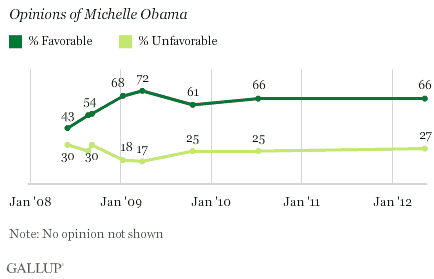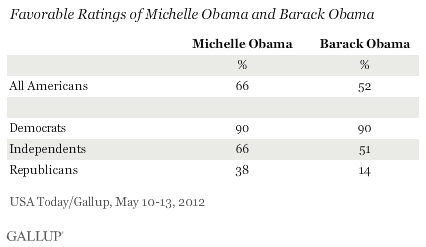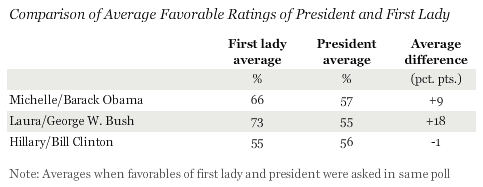PRINCETON, NJ -- Sixty-six percent of Americans have a favorable view of first lady Michelle Obama, unchanged from nearly two years ago and in line with her ratings since Barack Obama was inaugurated as president.

Michelle Obama's current favorable rating is identical to her average 66% rating to date as first lady. Americans did not view her as positively during the 2008 presidential campaign, giving her favorable ratings no higher than 54%. Opinions of her became considerably more positive in January 2009, rising to 68%, just before the inauguration.
Americans also viewed each of the prior two first ladies positively, with Laura Bush averaging a 73% favorable rating and Hillary Clinton 56%. Clinton, now the U.S. secretary of state, currently receives favorable ratings from 66% of Americans.
Gallup began asking favorable and unfavorable opinions of national figures in the current question format in 1992, so it does not have comparable data on first ladies prior to Clinton.
Michelle Obama More Popular Than Barack Obama
The same May 10-13 poll that measured Michelle Obama's favorable rating found 52% of Americans having a favorable opinion of Barack Obama. Michelle Obama has a higher favorable rating than the president among independents and Republicans. Democrats view the two equally positively.

Americans generally have more positive opinions of the first lady than of the president, perhaps because of the first lady's largely ceremonial position. To date, Michelle Obama's favorable rating has averaged nine percentage points higher than her husband's, when both were asked in the same poll. Laura Bush's average favorable rating was 18 points higher than George W. Bush's, and she remained popular with Americans even as her husband's job approval rating sank.

Hillary Clinton's favorable ratings averaged about the same as Bill Clinton's during the course of his presidency. But the averages hide the fact that she was viewed more favorably than he was after the Monica Lewinsky scandal, 59% to 55%. Before the scandal, Americans were more positive toward Bill Clinton, 57% to 53%.
Implications
Michelle Obama remains well-liked by Americans, something that has been common for recent first ladies regardless of the popularity of the president.
Given Americans' positive feelings toward the first lady, it is possible the Obama re-election team will consider using her to campaign on behalf of her husband this election year. But if Michelle Obama were to enter the political arena, it could have a negative effect on how Americans view her -- as suggested by the fact that Americans viewed her less positively during the 2008 election year than afterward. Though the data for Laura Bush and Hillary Clinton are inconclusive, some of Hillary Clinton's lowest favorable ratings came during Bill Clinton's 1996 re-election year.
But even if Michelle Obama's image suffers to some extent by her taking on a more overtly political role this year, it is possible her image would recover once she steps back from that role.
Survey Methods
Results for this USA Today/Gallup poll are based on telephone interviews conducted May 10-13, 2012, with a random sample of 1,012 adults, aged 18 and older, living in all 50 U.S. states and the District of Columbia.
For results based on the total sample of national adults, one can say with 95% confidence that the maximum margin of sampling error is ±4 percentage points.
Interviews are conducted with respondents on landline telephones and cellular phones, with interviews conducted in Spanish for respondents who are primarily Spanish-speaking. Each sample includes a minimum quota of 400 cell phone respondents and 600 landline respondents per 1,000 national adults, with additional minimum quotas among landline respondents by region. Landline telephone numbers are chosen at random among listed telephone numbers. Cell phone numbers are selected using random-digit-dial methods. Landline respondents are chosen at random within each household on the basis of which member had the most recent birthday.
Samples are weighted by gender, age, race, Hispanic ethnicity, education, region, adults in the household, and phone status (cell phone only/landline only/both, cell phone mostly, and having an unlisted landline number). Demographic weighting targets are based on the March 2011 Current Population Survey figures for the aged 18 and older non-institutionalized population living in U.S. telephone households. All reported margins of sampling error include the computed design effects for weighting and sample design.
In addition to sampling error, question wording and practical difficulties in conducting surveys can introduce error or bias into the findings of public opinion polls.
View methodology, full question results, and trend data.
For more details on Gallup's polling methodology, visit www.gallup.com.
